Recently, Prof. Renming Liu from the School of Physics and Electronics has made a series of new progress in the study of plasmon-exciton strong coupling at ambient conditions, in cooperation with Sun Yat-sen University and other institutions. The related papers have been published in the authoritative journals of Physical Review Letters, Nano Letters, and Science China-Physics, Mechanics & Astronomy.
Research progress I: Realizing the highly efficient single-exciton strong coupling with plasmons

Realizing the single-exciton strong coupling with localized plasmon mode (LPM) at room temperature is highly desirable for exploiting quantum technology. However, its realization has been a very low probability event due to the harsh critical conditions, severely compromising its application. To overcome this challenge, Prof. Renming Liu cooperating with Xue-Hua Wang’s research group present a highly-efficient approach for achieving such a strong coupling by reducing the critical interaction-strength at the exceptional point based on the damping inhibition and match of the coupled system, instead of enhancing the coupling strength to overcome the system’s large damping. Experimentally, they compress the LPM’s damping linewidth from ~45 nm to ~14 nm, using a leaky Fabry–Perot cavity, a good match to the excitonic linewidth of ~10 nm. It dramatically relaxes the harsh requirement in mode volume by more than an order of magnitude and allows the maximum direction angle of the exciton dipole relative to the mode field up to ~71.9°, significantly improving the success rate of achieving the single-exciton strong coupling with LPM from ~1% to ~80%, which will greatly boost an advance in room-temperature quantum devices.
The related paper entitled with "Highly Efficient Single-Exciton Strong Coupling with Plasmons by Lowering Critical Interaction Strength at an Exceptional Point" has been published in Physical Review Letters. Dr. Wei Li is the first author, Prof. Renming Liu and Prof. Xue-Hua Wang are the corresponding authors. The research work is supported by the National Key R&D Program of China, the National Natural Science Foundations of China, the Key-Area Research and Development Program of Guangdong Province, and the Guangdong Special Support Program.
Research progress II: Strong coupling between a deterministic single quantum dot and a single plasmonic nanoparticle

A single quantum dot (QD) strongly coupled with a plasmonic nanoparticle yields a promising qubit for scalable solid-state quantum information processing at room temperature. However, realizing such a strong coupling remains challenging due to the difficulty of spatial overlap of the QD excitons with the plasmonic electric fields (EFs). In this work, Prof. Renming Liu cooperating with Xue-Hua Wang’s research group demonstrate for the first time that this overlap can be overcome by integrating a deterministic single QD with a single Au nanorod. When a wedge nanogap cavity consisting of them and the substrate is constructed, the plasmonic EFs can be more effectively “dragged” and highly confined in the QD’s nanoshell where the excitons mainly reside. With these advantages, we observed the largest spectral Rabi splitting (reported so far) of ∼234 meV for a single QD strong coupling with plasmons. This work opens a pathway to the massive construction of room-temperature strong coupling solid qubits.
The related paper entitled with "Room-Temperature Strong Coupling Between a Single Quantum Dot and a Single Plasmonic Nanoparticle" has been published in Nano Letters. Drs. Jun-Yu Li and Wei Li are the co-first authors, Prof. Renming Liu and Prof. Xue-Hua Wang are the corresponding authors. The research work is supported by the National Key R&D Program of China, the National Natural Science Foundations of China, the Key-Area Research and Development Program of Guangdong Province, the Guangdong Special Support Program, and Henan University.
Research progress III: Realizing strong coupling between a plasmon mode and multiple exciton states
At present, most of the studies on plasmon-exciton strong coupling are based upon a single exciton state, and only two hybrid quantum states are generated, which is not enough to meet the requirements of room-temperature quantum information processing based on multiple qubits. Therefore, it is important to develop the theoretical model and experimental platforms of strong coupling between a plasmon mode and many different exciton states. Based on the theoretical research (Phys. Rev. B 103, 235430 (2021)), the research group of Prof. Renming Liu has developed a quantum approach for accurately describing the strong coupling between a plasmon mode and multiple exciton states. By constructing the hybrid system of Au@Ag NR/S0041@S2165@2278 J-aggregates via the electrostatic assembly technology, the strong coupling between plasmons and three different exciton states is demonstrated, and the transient absorption of the hybrid system is also investigated using femtosecond laser ultrafast pump-detection technology. It is found that the mixed states generated by the strong coupling have a mutual modulation effect with the acoustic phonon oscillations of the metal nanocavities. This work not only provides a powerful theoretical tool for studying the multimode hybridization and coherent multiqubit manipulation at room temperature, but also provides ideal testbeds for investing charge-transfer transitions and developing nanophononic devices to probe electronic, thermionic, and phononic states.

The related paper entitled with "Strong coupling between a plasmon mode and multiple different exciton states" has been published in Science China-Physics, Mechanics & Astronomy. Postgraduates Junjun Ye, Yatao Pan and Dr. Guanghui Liu are the co-first authors, Profs. Renming Liu, Xia Ran and Lijun Guo are the corresponding authors. The research work is supported by the National Natural Science Foundations of China and Henan University.
The links to these papers:
https://journals.aps.org/prl/abstract/10.1103/PhysRevLett.130.143601
https://pubs.acs.org/doi/abs/10.1021/acs.nanolett.2c00606
https://link.springer.com/article/10.1007/s11433-022-2029-9
https://journals.aps.org/prb/abstract/10.1103/PhysRevB.103.235430

 News /
Content
News /
Content


